We have recently been posting about the different types of bacteria and parasites that are commonly found in your koi fish.
Here is a combined list of those common illnesses and “diseases” we have posted about, highlighting how you can identify and treat them.
NOTE: Whenever you use chemicals or medications to help combat a particular affliction ALWAYS, ALWAYS use the manufacturer’s recommended dosage. Failure to do so can result in the death of the koi in treatment as well as its pond or tank mates.
Click on the name to jump to the topic
Aeromonas
Chilodonella
Fish Lice
Ich
Anchor Worms
Columnaris
Costia
Dropsy
Carp Pox
Aeromonas
Type: Bacteria
AKA: Aeromonas hydrophila, Ulcer Disease, Hole In the Side disease
How to Diagnose
- Flashing
- Lethargy
- Loss of appetite
- A small red or white pimple forms on the skin
- A lesion with scales missing
How to Treat
- Quarantine
- Raise water temperatures to 80-82ºF
- Feed Medicated food
- Clean the wound with Hydrogen peroxide
- Add topical antibacterial or inject baytril
- Bathe in tricide-neo
- Raise salinity
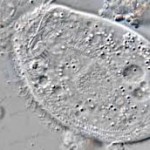 Chilodonella
Chilodonella
Type: Protozoan parasite
AKA: Lernaea elegans
How to Diagnose
- Need a microscope for proper diagnosis
- Ear- or heart-shaped with cilia (small hairlike structures) on the ventral side
- Fins clamped
- Flashing
- Rubbing
- Gasping at the surface
- Floating on their sides until disturbed
- More time near airstones or waterfalls (increased oxygen areas)
- Increased mucous production
- Skin looks cloudy
- Appetite loss
- Weight loss
How to Treat
- Standard parasite protocols are effective
- Malachite Green and Formalin
- Potassium permanganate bath
- Salt dip (2.5%)
- Salt bath (0.5%)
- Extra aeration
- Smaller doses of food
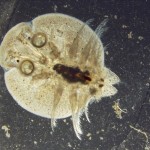 Fish Lice
Fish Lice
Type: Crustacean ectoparasite
AKA: Argulus foliaceus
How to Diagnose
- Visible to the naked eye
- Look for pencil-lead sized, algae-colored, horseshoe-crab shaped creatures
- Rubbing
- Flashing
- lethargy
- Appetite loss
- Red lesions (where the parasite has attached)
How to Treat
- Dab Potassium permanganate on the lice directly
- Carefully remove lice with tweezers
- Use topical antibacterial ointment on open lesions
- Medicated food
- Follow up treatments may be necessary due to egg life cycle and adult-stage hardiness
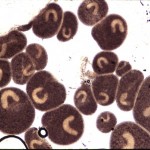 Ich
Ich
Type: Protozoan parasite
AKA: Ichthyophthirius multifilis
How to Diagnose
- Need a microscope for proper diagnosis
- U- or horseshoe-shaped nucleus in a round body
- Flashing (rubbing against the sides or bottom of the pond bottom),
- Lethargy
- Appetite loss
- Small white spots like grains of salt
How to Treat
- Difficult to treat while on the host koi
- Salt solution of 0.3%-0.5% at no more than 80ºF
- Raise salinity slowly to acclimatize fish
- Monitor water temps for salting periods
- 50ºF 14-21 days
- 60ºF from 10-12 days,
- 65-70ºF from 7-8 days
- 75-80ºF 2-5 days
- Try malachite green and formalin if salt is ineffective
- Clean media where possible
- Gradual 30-40% water changes
 Anchor Worms
Anchor Worms
Type: Crustacean parasite
AKA: Lernaea elegans
How to Diagnose
- Visible to the naked eye
- Look like greenish white threads or pieces of floss
- Flashing
- Red, inflamed spots (where the parasite is embedded)
- Ulcerations on the skin
- Difficulty breathing
- Lethargy
- Loss of appetite
How to Treat
- Standard parasite protocols are most effective
- Potassium permanganate—either as a dip in a quarantine tank or entire pond (5-10ppm)
- Dimilin
- Formalin (exercise caution if it has open wounds, though)
- Salt dip (to lessen secondary infection)
- Anchor worms can be removed with tweezers
- Grab them as close to the entry point as possible
- Make sure that the entire parasite is pulled
- Disinfect the wound afterwards (to minimize infection)
- Only keep the koi out of the water for a few seconds at a stretch (and especially if it is already stressed)
- Removal may cause more stress and trauma than leaving it in, so treating them chemically can be a better alternative
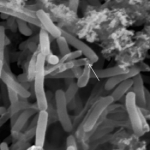 Columnaris
Columnaris
Type: Bacteria
AKA: Cottonmouth, Fin Rot, Tail Rot, Saddleback disease, Flavobacterium columnare
How to Diagnose
- The fins and tail look ragged
- Sores or lesions will develop on the body, eventually becoming ulcers
- A lesion around the dorsal fin is common, banding around the fish
- Koi develops a white milky sheen in patches over the body
- Discolored mucous around the mouth, eyes and on the head and dorsal regions.
- Gills will become a discolored, brown color
- Breathing shallowly and rapidly
- Lethargy
- Appetite and weight loss
- Lot of time near the surface
- Resting for long periods on the pond/tank bottom
How to Treat
- Quarantine immediately
- Lower the tank temperature to reduce virulence
- Start with 0.5% solution salt bath
- 30-50% water change to reduce risk of spreading rapidly through the water column
- Clean the pond floor media to remove as much waste as possible
- Potassium Permanganate bath is the most common treatment
- Treating external infections with hydrogen peroxide
- Use Nitrofuran-based antibiotics (like Nitrofurazone or Furazolidone)
- Feed koi antibiotic medicated foods
- Finish the course to limit chance for future resistance
- Clean all tanks thoroughly
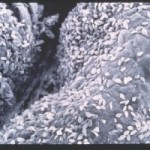 Costia
Costia
Type: Flagellate protozoan parasite
AKA: Ichthyobodo necatrix
How to Diagnose
- Need a microscope for proper diagnosis
- Look for fast-moving, kidney-shaped body with two flagella
- Loss of appetite
- Lethargy (long periods of not moving)
- Fin clamping
- Labored (or “heavy”) breathing
- Rubbing
- Red lesions with white slime
- Increased slime production (which appears blue-grey in color)
- Mucous coming out of the gills
How to Treat
- Start with single Potassium Permanganate treatment
- should not be used if there is gill damage
- turn off UV light (where applicable)
- Salt treatment (either in a separate bath or as a long-term pond treatment)
- 3% Hydrogen peroxide on the open lesions to slow its growth
- Single dose of anti-parasite treatments (like malachite green and formalin)
- Raise the water temperature to the low 90ºF range
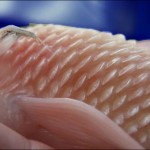 Dropsy
Dropsy
Type: Multifaceted causes (viral, parasitic bacterial, congenital), but damage mostly due to bacterial infection
AKA: Pinecone, Bloater disease, Pop-eye disease
How to Diagnose
- Eyes bulging out
- Distended (bloated) stomach
- Raised scales (so it looks like a pine cone
- Gasping
- Unbalanced swimming (as the swim bladder is affected by the excess fluid, too)
- Appetite loss
- Once these physical symptoms are noticeable, it is usually too late
How to Treat
- Act quickly
- Isolate affected koi
- Raise water temps
- Increase oxygenation
- Adopt antibacterial regimen
- Antibiotic regimen may include tetracycline, naladixic acid, penicillin or baytril
- Use antibiotics (either injected or in feed)
Carp Pox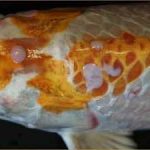
Type: Virus
AKA: Cyprinid Herpesvirus 1
How to Diagnose:
- White, grey, blue or pinkish spots that look like molten wax
- Look for spots on head, shoulders and fins (sometimes they will cover the whole body)
How to Treat
- As a virus, and without an effective antiviral option, prevention of an outbreak is the best treatment
- Reduce potential stressors:
- lower your fish load
- optimal water parameters
- high dissolved oxygen levels
- be vigilant of ammonia
- monitor pH closely
- Periodic Chloramine T dosing (reduces opportunistic pathogen instance)

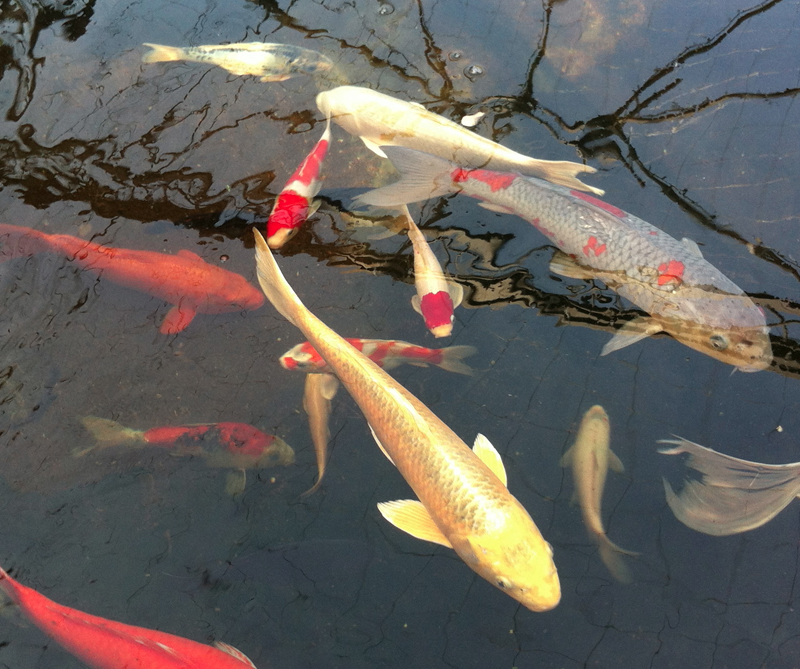

Hi, can be Costia be treated with human medication such as metrodanizole?
No, it is not recommended that you use human medications to treat your fish.
My koi has milky like Area on his back that looks like melted candle wak. Puts his fins down on his back sometimes. Hangs at waterfall. Has back humped. Where the melted wax like stuff is his scales are now fallibg off. What could be wrong with him and what can i do?
Hi Debra,
What you have described sounds like Carp Pox. This is a strand of virus that cause the waxy spots you mentioned. Although it is usually something you would see in the fall or during cooler water temps. It is not life threatening, but you could add pond salt to your water to help reduce any stress this fish could be experiencing. You can read more about this via the link provided below.
https://nextdaykoi.com/koi-fish-facts/carp-pox-and-your-koi/
However, you CAN use metronizadole for fish. It’s the same thing, but for fish. Follow the directions on the bottle that is for fish dosage. It’s used for bacterial infections.
I have an old Comet Goldfish the fins have started turning black from the outer edges inward almost looks like rotting ?
The other fish seam fine so far.
Some of my Koi have small black spots, still have good appetite, but spots concern me. I enjoy my Koi, just concerned with the dark spots. Any ideas, this had good things, but they don’t describe the dark spots!? They’re small but noticeable!
Thank you
Jean
It sounds as though the spots could be a potential result of Ammonia burn. We suggest checking your water parameters for adequate readings. Please feel free to contact us directly if you have any other questions or concerns: sales@nextdaykoi.com.
My one white koi as brown looking fur on him. What can I do or used
Hi Tony, While we can not say for sure, this sounds to be saprolegnia. This is form of fungus. This can generally happens due poor water quality, too much waste in the water, or overcrowding. A method of treatment would be to use a paste of potassium permanganate or hydrogen peroxide on the effected areas.
LARGE YELLOW &BLACK KOI RED AT THE TIP OF TAIL FINS
Just lost a koi today . Floated to surface after swimming slow and lethargicly. Was black and yellow. The yellow has turned to orange.
I am going to ask an ailment issue. We have a fairly large koi that has been standing on its head for a week now , I have it isolated and am slowly raising temperature that started at 47 Fahrenheit. Any ideas??
Hi Steve, We apologize, as we do not have a clear answer on what may be causing this behavior, as it could be due to a few different reasons. Usually, one might see this behavior due to cooler water temperatures, but it is generally more associated with water quality issues. More specifically a spike in either pH or ammonia. We would advise to check your water parameters for proper levels for the fish. If off, make the needed changes to get the numbers back to safe. You may also want to treat the fish with a general cure type medication in the event the fish may be developing a potential bacterial, fungal, or parasitic infection.
I think my koi got bit by one of my turtles. What can I do to help heal the wound?
We are sorry to hear that a Turtle may have bit one of your fish. If this is the case, we would advise trying to remove or rehome the turtle from your pond, as fish are a part of their diet and it could certainly happen again. Depending on the severity of the wound, we would recommend isolating and quarantining this fish for closer monitoring. Raising the salinity by adding pond salt to its water can reduce stress and promote natural healing of the affected area. 0.35% salinity would be a beneficial place to start.
My koi seem to be off. A couple have, what looks like, a red wart type of thing on the tip of their noses (so to speak). Another has the same weird thing on its tail and a few look like their eyes are bulging. We’ve been monitoring the water and according to the people who service our pond weekly the water is good. Any thoughts?
Hi Denise,
We are sorry to hear that some of your fish are displaying some of the symptoms that you have described. While we can’t say for certain, it sounds as though they may be developing bacterial infections. If the fish became stressed for any reason, their immune systems will weaken and this can make them much more susceptible to bacteria and parasites that exist in the water, even if the water parameters are within acceptable ranges. We would advise consulting your pond professionals about quarantining any concerning fish or on a treatment option for the full pond.
Thank you.
[…] How to Recognize and Treat Common Koi Fish Illnesses […]
[…] How to Recognize and Treat Common Koi Fish Illnesses … […]
[…] How to Recognize and Treat Common Koi Fish Illnesses […]
[…] How to Recognize and Treat Common Koi Fish Illnesses […]
[…] How to Recognize and Treat Common Koi Fish Illnesses […]
[…] How to Recognize and Treat Common Koi Fish Illnesses […]